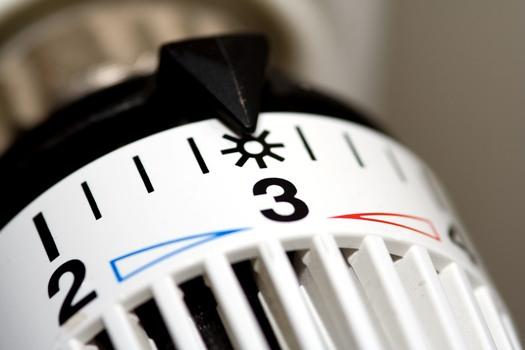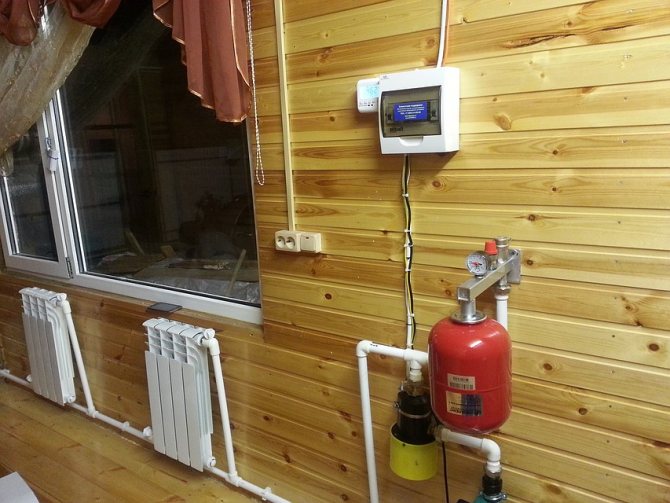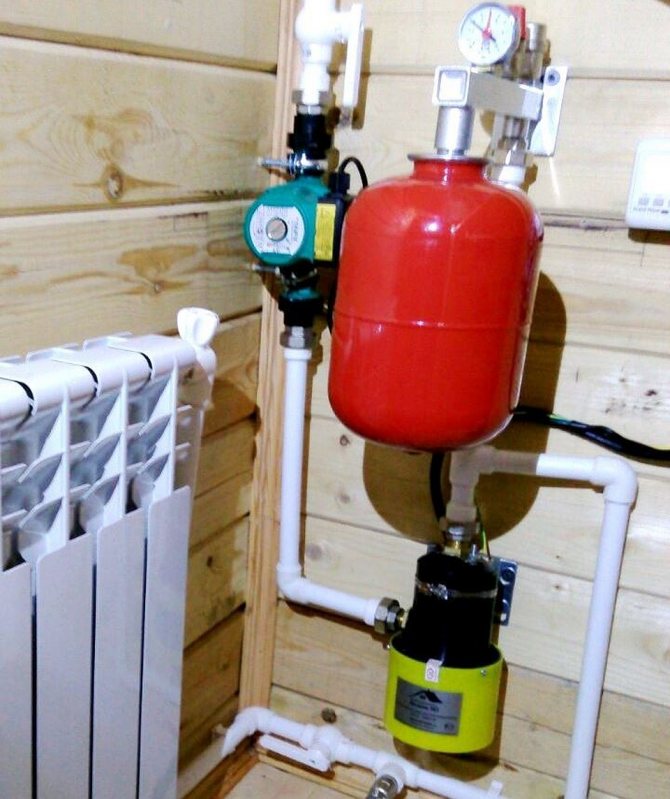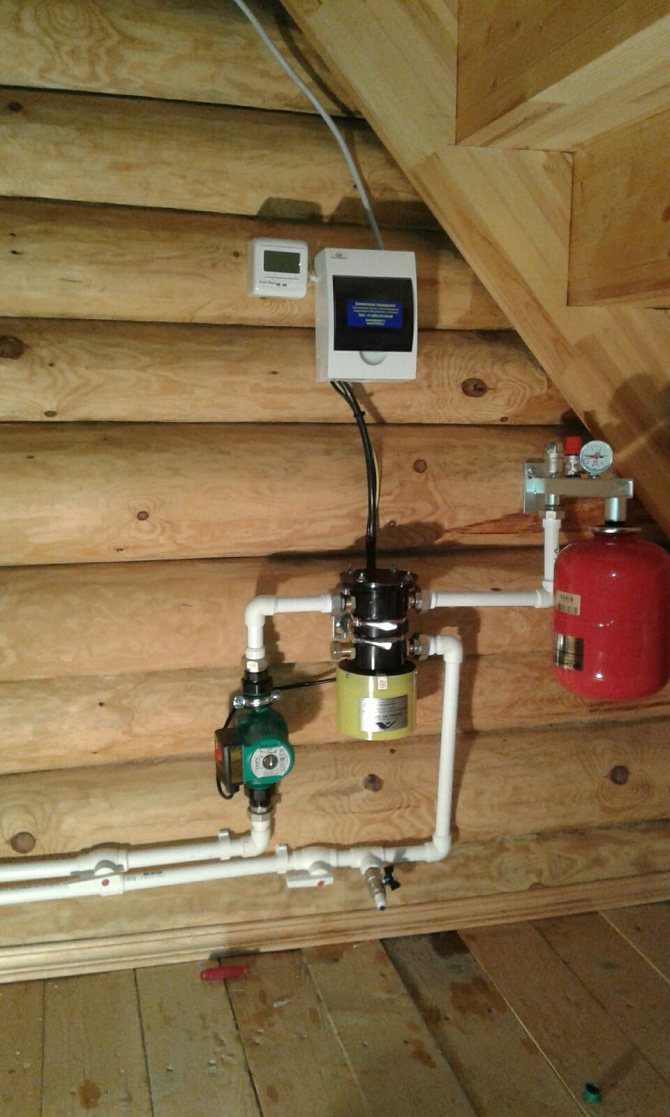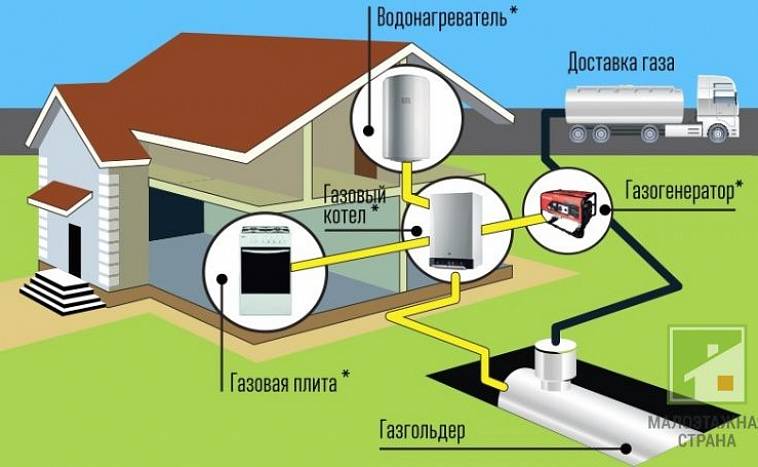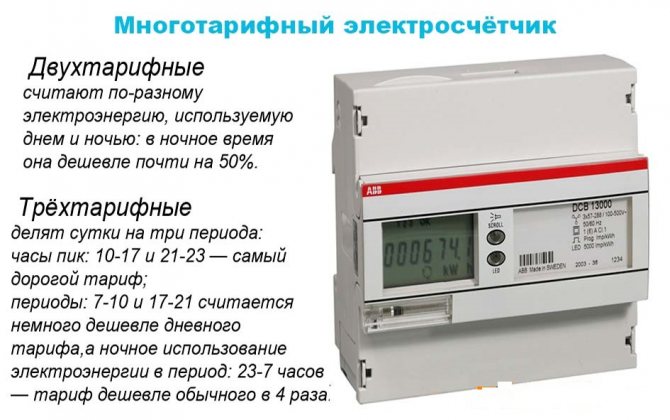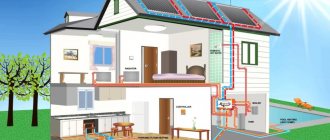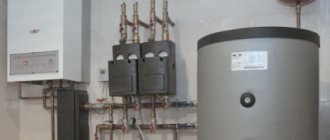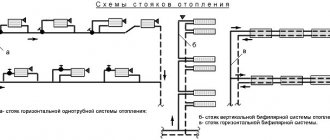The question of the device of an autonomous heating system deserves a thorough comprehensive consideration, because the costs for it make up a significant part of the budget. For a balanced determination of a suitable option, you need to determine in advance which is cheaper - gas or electricity. This often depends on many factors.
On the one hand, there are one-time costs for the installation of equipment and communications, and on the other, there are annual payments for gas, electricity, maintenance of devices and devices. All this can be calculated independently. The result will help you make an informed choice in favor of one of the methods of heating your home.
You will find detailed answers to really significant questions in our article. We will show you how and by what criteria the economic side of the organization of the heating system is determined. Our recommendations will help you decide which option will be more practical.
The main types of heating costs
To correctly assess the cost of heating a country house, you need to take into account all types of costs that the homeowner will have to incur.
When using gas or electricity, it is possible to organize automatic heating. This gives many advantages to people living in a country house and allows you not to waste your time on maintaining the desired indoor climate. However, automation will increase the cost of both systems.

The presence of a gas pipeline near the house does not mean the ability to connect to it. To find out the answer, you need to request technical specifications from the gas supply organization. They are issued free of charge
Costs can be typified as follows:
- Capital investments for the installation of a heating system based on gas or electricity differ only in the supply of communications, the cost of the boiler and the price for its connection. The water circuit, shut-off and control valves do not depend on the type of energy carrier.
- Annual expenses for equipment repair and maintenance. This expense item is usually the smallest, but you also need to remember about it.
- Energy cost costs. They depend on the consumed volume, tariffs adopted in the region, the location of the facility (urban or suburban area) and some other factors.
Thus, the cost S (rubles) can be calculated using the following formula:
S = N + (R + E) × Twhere:
- N - capital investments;
- R is the annual cost of equipment repair;
- E is the annual cost of the energy carrier;
- T is the number of years in the billing period.
When comparing several heating options, a situation often arises when high one-time equipment costs can pay off over time due to the relative cheapness of the energy carrier.
Steam heating: advantages and disadvantages
Steam heating implies the following mechanism: in the boiler, water is heated to the boiling point, and the resulting steam enters the radiators. The steam is then condensed into liquid and returned back to the boiler.
Advantages:
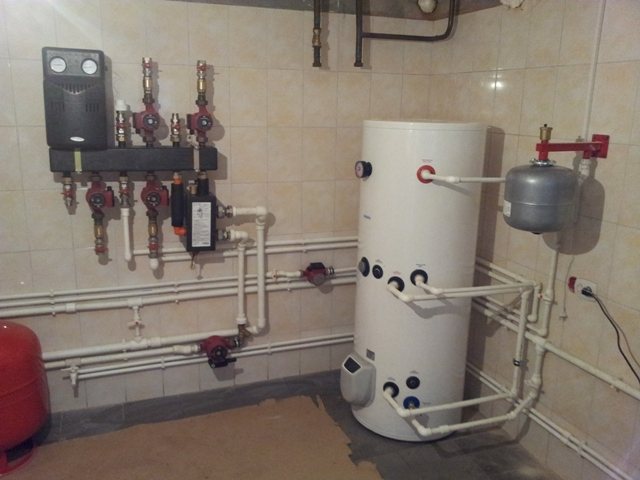

- high heating rate regardless of the area of the house;
- no heat loss in heat exchangers;
- ecological cleanliness of the coolant;
- the cyclicity of the coolant - steam can be used several times;
- the minimum probability of freezing of the structure.
There are also negative aspects of such heating:
- there is no possibility of regulating the temperature inside the house;
- short service life of the system due to the high temperature of the coolant;
- high likelihood of corrosion by vapors;
- the need to install a lattice.
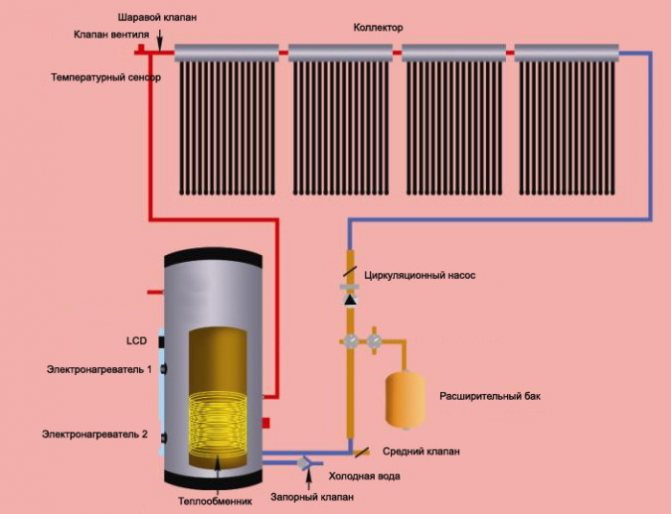

The boiler can operate on the basis of gas, solid, liquid or combined fuel. In order for the heat transfer of the equipment to be as efficient as possible, it is necessary to choose it correctly. So for heating a private house with an area of 60-200 m², a unit with a capacity of 25 kW is required (if the area is 200-300 m², then the boiler power must be at least 30 kW).
The steam heating system can operate on various fuels: gas, wood, electricity, coal. Combined heating options are increasingly being used to heat a house, for example: gas and electric.
Competently combining fuel, you can save on heating your home.
How much fuel is required
Example 2. Calculation of gas consumption for steam heating. Suppose the area of a private house is 100 m². Accordingly, the power of the boiler for heating is 25 kW.
- 25 kW * 24 hours * 30 days = 18,000 kW / hour. This figure does not reflect an adequate situation, since the boiler does not always work at full capacity. The average value is more acceptable in this case. 18000/2 = 9000 kW / h.
- 7 months * 9000 kWh = 63000 kWh - annual fuel consumption.
- Considering that 1 m³ of fuel produces 10 kWh of energy, we get: 63000/10 = 6300 m³.
- In monetary terms: 6300 * 4.97 = 31311 rubles per year.
Capital investment and equipment support
The costs of connecting an electric boiler "from scratch" are insignificant in comparison with equipment that runs on gas. It can be installed in any free space, even in a residential area.
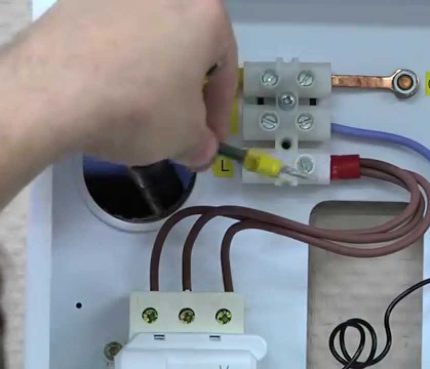

Powerful electric boilers operate from 380 V. Therefore, when installing such equipment, you will have to spend money on a three-phase connection at home
Installing gas equipment is much more difficult and expensive, as you have to follow these steps:
- Obtain technical specifications from the local gas supply organization. It is necessary to indicate the estimated gas consumption.
- Arrange a separate place for the boiler with adequate ventilation. The boiler will be handled by a specialist from the gas company before its start-up and an annual safety check.
- Lay gas communications in the premises. In order to avoid problems with acceptance, it is better for a specialist of the gas company to do this.
- Arrange a system for the removal of combustion products.
When choosing a system that runs on liquefied gas, it is necessary to organize the installation of a gas holder, since it will be very expensive to heat a house with cylinders. In addition, cylinders will often have to be refueled, so the heating process can hardly be called automatic.
For small houses and warm regions where gas consumption for heating is insignificant, several cylinders can be combined using a ramp, but this solution is also less economical than even a small-volume gas tank.
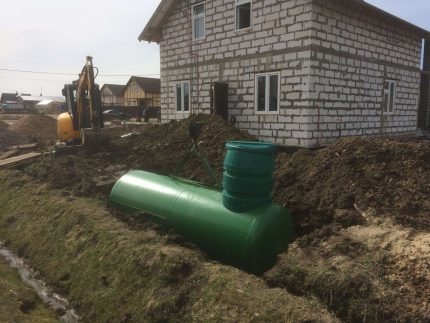

The gas tank can be installed in a pit designed on either side of the house. The communications connected to it will not be visible and will not interfere with arranging the lawn. However, it is impossible to place beds and household buildings above the equipment and pipelines - it is necessary to preserve the ability to monitor the state of the system, service and repair
Designing and connecting to the gas pipeline also requires significant funds. The price for this service depends on the region of residence and the topology of the site on which the cottage is located.
On average, the estimate, installation of the gas pipeline from the outlet to the gas consumer and the commissioning of the site can cost from 80 to 300 thousand rubles.
Air heating
The air heating system consists of a heat generator and a water heater, which is responsible for heating the air. The fan and distribution heads distribute the air masses throughout the house.
Specifications
The advantages of an air heating system are: high efficiency (93%), the ability to warm up the room in the shortest possible time, maintaining the optimal temperature.Also, the heating system with an air intake can be equipped with air ionizers or cleaning filters.
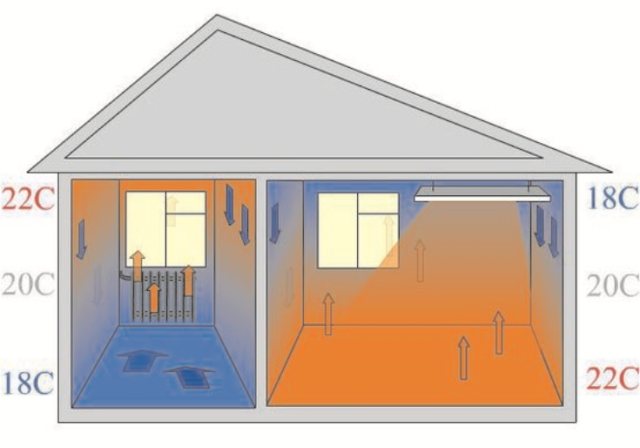

Among the disadvantages of air heating are the following:
- an air heating system can be installed only at the stage of building a house;
- regular service is required;
- high demand for electricity (an additional power supply will be required);
- air filters need to be changed frequently;
- high installation and maintenance costs;
- pulling in dust from the street (applies only to the forced draft system).
The air heating system can use gas or diesel fuel. The calculation of fuel consumption is similar to example No. 1.
Estimation of the required volume of energy carrier
Many cottages were built according to individual projects using building materials of different structure and heat engineering, thermal insulation, and decoration. In addition, the climatic parameters of winter for different regions can be very different. Therefore, in the calculations of the amount of energy that will be needed to heat a house, there can be significant differences.
Calculation of the required amount of heat
Heating is designed to compensate for the heat loss of the building, which occurs for two reasons:
- loss of energy due to freezing of the perimeter of the house;
- replacement of warm air with cold air during ventilation.
In order to understand what is more profitable to heat a private house - with gas or electricity, it is not necessary to carry out high-precision calculations. An approximate estimate (± 20%) of the amount of heat loss for the winter period is sufficient to determine the difference in the final cost of the energy carrier.
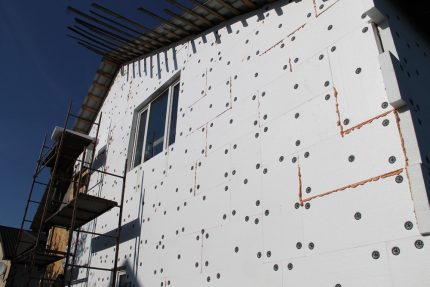

Warming a country house is a great way to save on heating. This will not reduce capital expenditures, but will reduce annual gas or electricity bills.
There are two options according to which it is possible to determine the amount of heat loss with acceptable accuracy:
- Order the calculation of this parameter from heating engineers. In this case, in order to save money, it should be mentioned that the calculations can be carried out using a simplified method.
- Carry out calculations on your own, knowing such parameters as the coefficients of resistance to heat transfer of materials at home, the area of the perimeter and roof, the volume of ventilation, the temperature difference, etc.
The obtained results of heat loss should be reduced to the standard unit of measurement - W.
Electricity and gas consumption
Instead of calculating heat loss, you can use the analogy method. If nearby (the coincidence of climatic conditions is very important) there is a building similar in geometry and material, then you can find out the volume of gas or electricity consumed by the meter readings.
In this case, we have three options:
- the heat loss of the building is known;
- there is data on the volume of gas consumed at a similar facility;
- the amount of electricity consumed for heating is known.
It is necessary to find out the volume of electricity and gas consumption for the winter period.


If the boiler also provides hot water supply, then the additional consumption of electricity or gas will need to be taken into account in the calculations
First of all, you need to determine the duration of the heating period E (hour). This can be done according to column number 11, table number 1 SNiP 23-01-99. To do this, you need to select the nearest settlement and multiply the number of days by 24 hours.
Since the calculations allow insignificant approximations, we will set the following constants:
- The efficiency of the electric boiler is 98%;
- The efficiency of a gas boiler is 92%;
- calorific value of natural gas is 9.3 kWh / m3;
- the calorific value of liquefied gas is 12.6 kWh / kg.
In this case, the basic transformation formulas will be as follows:
- The volume of consumed natural gas V (m3) is known. Heat loss of the building: Q = V × (9300 × 0.92) / E.
- The mass of the consumed liquefied gas V (kg) is known. Here, for the propane-butane mixture, the ratio 1 kg = 1.66 l can be used.Heat loss of the building: Q = V × (12600 × 0.92) / E.
- The amount of consumed electricity V (Wh) is known. Heat loss of the building: Q = V × 0.98 / E.
- The heat loss of the building is known Q. The required volume of natural gas: V = Q × E / (9300 × 0.92).
- The heat loss of the building Q is known. The required volume of liquefied gas: V = Q × E / (12600 × 0.92).
- The heat loss of the building Q is known. The required amount of electricity: V = Q × E / 0.98.
Calculation of heat losses of a building has another purpose - they can be used to calculate the maximum consumption of electricity and gas in the coldest five-day period of the season. This will help to select the correct boiler power and avoid overload problems.
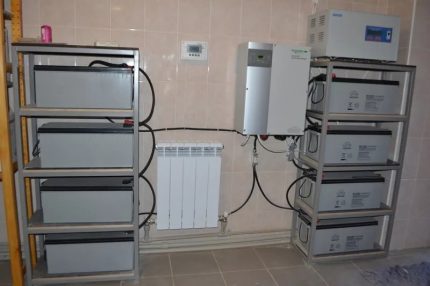

During extreme cold snaps, electricity consumption increases dramatically, which can lead to failures. Therefore, you need to have a backup power supply or use heat accumulators.
When comparing the cost of gas and electric heating, the autonomous power supply system does not need to be taken into account, since in extreme frosts it can be used with any type of fuel.
Stove heating
Stoves and fireplaces are used for heating housing. For cottages, these options are ineffective, since they do not provide an even distribution of heat throughout the premises. It is better to choose them for use in summer cottages.
To decide which heating is more suitable for a private house, you need to choose the cheapest and most affordable fuel in your area. The price of artificial heating of a residential building directly depends on its consumption and cost. There is no one size fits all option. Gas remains the most economical source of heat energy. In an area where there are no main gas pipelines, you should pay attention to solid fuel and electrical resources.
Tariffs and final cost calculation
Knowing the amount of energy consumed and its cost, you can calculate the cost of heating by simple multiplication. This is true for gas, but there are some nuances for electricity.
In rural settlements, as well as in city apartments or private houses that are not connected to gas, there is a lowering coefficient of payment for electricity. To confirm the right to use the preferential tariff, it is necessary to submit a package of documents to the organization providing the supply of electricity.
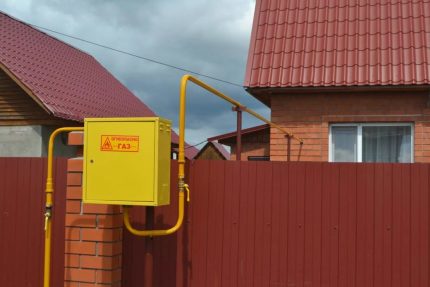

If gas is supplied to the house, but the owner does not want to use it, then this will not be the basis for applying a reduction factor
There is also another way to reduce electricity bills - to switch to a tariff differentiated by time of day. To do this, you need to apply to the sales company and purchase a multi-tariff meter.
In order for the boiler to work only at night, you will have to organize a special accumulator for the coolant. It is a well-insulated container of large capacity. This also requires some investment.
Private house heating options
Any type of heating is designed to make a person's life as comfortable as possible. Heating can be used to heat a private house:


- water;
- steam;
- air;
- electric;
- open fire structures: stoves, fireplaces.
The choice in favor of a heating system depends on the availability of fuel. For example, if there is a central gas pipeline nearby, then it is more profitable to install a gas structure.
Let's try to figure out which artificial heating system is more economical and affordable.
Example of calculating heating costs
Let's take as an example a cottage with an area of about 200 m2 in the vicinity of Barnaul. The average heat loss of a house made of aerated concrete with a 50 mm insulation will be about 8000 W, and the maximum - 18000 W. The duration of the heating period is 235 days or 5640 hours.
Let's calculate the capital costs for installing boilers and providing access to energy resources. When organizing home heating from electricity, the costs will be as follows:
- Connection of additional power up to 30 kW - 15 tr.
- Three-phase electric boiler Ferroli Zews 28, 28 kW - 51 tr.
- S-Tank heat accumulator of the HFWT series for 750 liters - 54 tr.
- Installation of equipment - 4 thousand rubles
Total: Ne1 = 70 thousand rubles, and taking into account the heat accumulator: Ne2 = 124 thousand rubles.
A boiler of this capacity is required if the consumer plans to heat the house at night using a differentiated tariff. When compensating for an average heat loss of 8 kW, a boiler power of 28 kW is required if the equipment will operate 7 hours a day. In extreme cold, a boiler of such power will have to be turned on during the day.
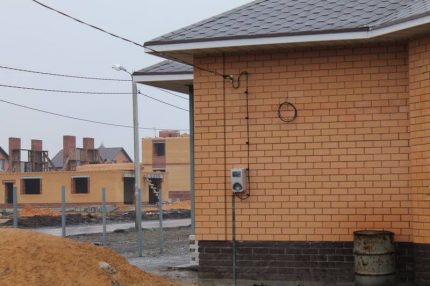

The power supply organization can connect more than 15 kW to the house only if it is technically possible. In case of overload or deterioration of the networks, a refusal can be received.
Let's calculate the capital costs for gas supply and installation of boilers operating from it:
- Technological connection of main gas. The house is classified in the first category, i.e. is located at a distance of less than 200 m from the pipe and does not require the installation of reduction gears. If this is not the case, then the price will be higher. The connection fee was 28 tr.
- Conducting a gas pipeline through the site. Preparation of a topographic plan, development of a project, its approval and registration, construction, installation and commissioning works. Payment under the work contract amounted to 85 thousand rubles.
- For liquefied gas, it is necessary to purchase and install an underground gas tank with a volume of 2.5 m3 and a pipeline to the boiler. Turnkey price - 270 thousand rubles.
- Gas boiler Viessmann WH1D272, with a capacity of 24 kW - 90 tr.
- Installation of equipment - 8 thousand rubles
- Putting the entire system into operation with the call of the Altaykraigaz inspector - 45 thousand rubles.
Total, capital costs for heating using main gas will be: Ng1 = 256 thousand rubles, and liquefied: Ng2 = 413 thousand rubles.
The cost of equipment maintenance (minor repairs and preventive maintenance) can be taken equal to 10% of its cost. However, for the supply of gas, it is necessary to conclude an agreement, and also to pay for the services of an annual inspection. Calling a BarnaulGorGas specialist will cost 3 thousand rubles.
Therefore, for an electric boiler, the cost of annual maintenance is: Re = 5.1 thousand rubles, and for gas equipment: Rпг = Rсг = 12 thousand rubles.


According to the Decree of the Government of the Russian Federation No. 410 of May 14, 2013, mandatory annual maintenance of indoor gas equipment can be carried out by organizations entered in a special register
Let's calculate the amount of energy required for the winter period:
- electricity: Ve = 46 mW × h;
- natural gas: Vпг = 5273 m3;
- liquefied gas: Vcg = 3892 kg.
Energy costs for the entire winter period will be as follows:
- Electricity. With a single-tariff connection in rural areas, 1 kWh costs 3.2 rubles. Ee1 = 46000 × 3.2 = 147.2 tr.
- Electricity. With a two-tariff connection in rural areas, 1 kWh = 2.07 rubles. Ee2 = 46000 × 2.07 = 95.2 tr.
- Natural gas. Its cost is 6.45 r / m3. Epg = 5273 × 6.45 = 34 tr.
- Liquefied gas. Its cost will be 36.1 r / kg. Eсг = 3892 × 36.1 = 140.5 tr.
The price for liquefied gas is given taking into account two fillings of a 2.5 m3 gas tank.
After these calculations, the heating cost equation will take the form:
- for electricity at the general rate: Se1 = 70 + 152.3 × T;
- for electricity at a two-zone tariff: Se2 = 124 + 100.3 × T;
- for natural gas: Sпг = 256 + 46 × T;
- for liquefied gas: Scg = 413 + 152.5 × T.
From these figures, you can get an idea of how profitable a particular type of fuel is.
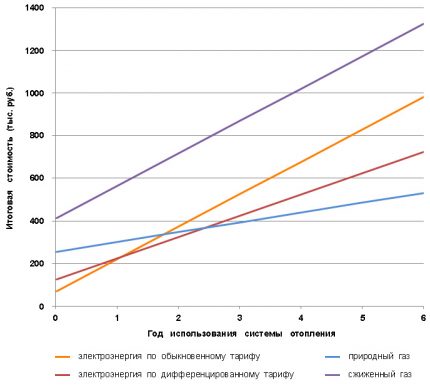

The dynamics of heating costs can be most easily traced by the graph of investment growth versus time. The equations are simple and linear
For this particular facility, it can be concluded that the best heating method is using mains gas. Within three years, it will be the most economical type of heating.
Installation of an electric boiler is cheaper and faster, as it requires fewer approvals. But subsequently, paying for electricity will lead to more serious expenses than using main gas. The two-tariff system will justify itself in the first year.
Heating on the basis of liquefied gas is economically absolutely unprofitable. It can be used only if there is no technical possibility of connecting to both main gas and electricity with a capacity of 30 kW or more.
Conclusions and useful video on the topic
Works on gas supply to the house and their cost on the example of a house in the Perm Territory:
About tariffs for the use of electricity when heating a house located in the city. Legal and technological nuances:
The use of gas and electricity to heat a house has its own characteristics. Electric heating equipment is easier and faster to connect, and natural gas is cheaper as a fuel. To determine the best economic model for heating, you need to carry out calculations for a specific facility and draw up a financial cost schedule.
Would you like to share your own opinion on the most rational and practical heating system? Do you have any useful information on the topic of the article that is worth sharing with your site visitors? Please leave comments in the block form below, ask questions, post photos.
Electric heating
You will be interested in: Determination of the financial result: accounting procedure, accounting entries
This method involves the use of boilers, which are divided into two types, namely floor-standing and wall-mounted.
The principle of operation is quite simple. The steel tank contains tubular electric heaters that convert electricity into heat. These elements heat the coolant, and then, thanks to the circulation of water, the building is heated.
